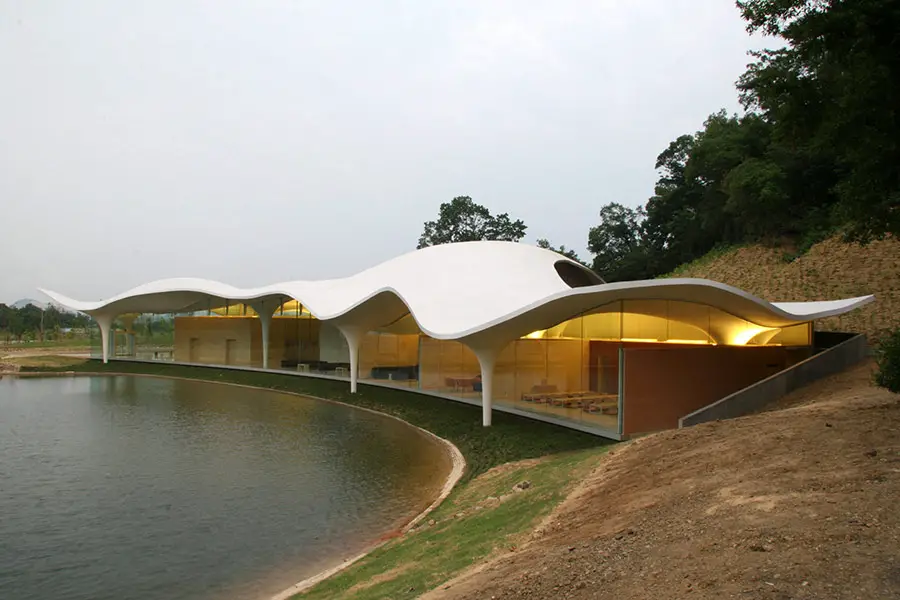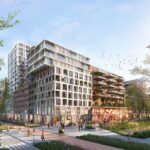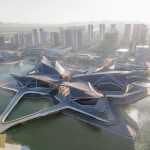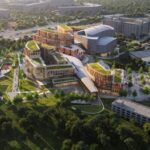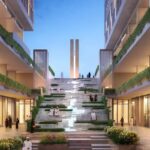Toyo Ito Architect Tokyo, Japanese Buildings, Architecture Practice, Office, Designs
Toyo Ito Architect Tokyo
Tokyo Architectural Practice, Japan Design Firm Images & News
post updated 18 Apr 2021
Toyo Ito Architect, Tokyo
20 + 18 Mar 2013
Pritzker Prize Winner 2013
The 2013 Pritzker Architecture Prize winner is Toyo Ito of Japan
Toyo Ito, a 71 year old architect whose architectural practice is based in Tokyo, Japan, will be the recipient of the 2013 Pritzker Architecture Prize, it was announced today by Thomas J. Pritzker, chairman of The Hyatt Foundation which sponsors the prize.
Pritzker Prize Architects : Winner in 2013
Dome in Odate design by Toyo Ito architect:
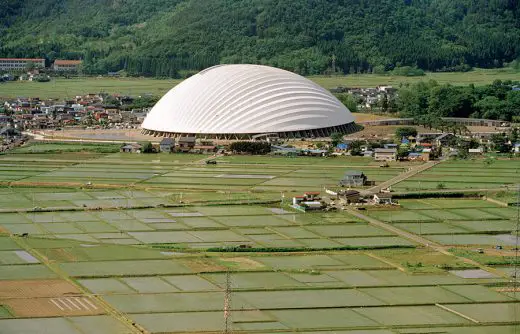
photo : Mikio Kamaya
Multipurpose Dome, Odate-shi, Akita, Japan
About Toyo Ito Architect
Toyo Ito was born on June 1, 1941 in Keijo (Seoul), Korea (Japanese). His father was a business man with a special interest in the early ceramic ware of the Yi Dynasty of Korea and Japanese style paintings.
He also was a sports fan of baseball and golf. In 1943, Ito, his mother, and his two elder sisters moved back to Japan. Two years later, his father returned to Japan as well, and they all lived in his father’s hometown of Shimosuwa-machi in Nagano Prefecture. His father died in 1953, when he was 12. After that the rest of family operated a miso (bean paste) making industry. At present, all but one sister who is three years older than Ito, has died.
Ito established his own architecture office in 1971, and the following year he married. His wife died in 2010. They had one daughter who is now 40 and is editing Vogue Nippon.
In his youth, Ito admits to not having a great interest in architecture. There were several early influences however. His grandfather was a lumber dealer, and his father liked to draw plans for his friends’ houses. When Ito was a freshman in high school, his mother asked the early Modernist architect, Yoshinobu Ashihara, who had just returned to Japan from the U.S. where he worked at Marcel Breuer’s office, to design their home in Tokyo.
He was in the third grade of junior high school when he moved to Tokyo and went to Hibiya High School. At the time, he never dreamed he would become an architect—his passion was baseball. It was while attending the University of Tokyo that architecture became his main interest. For his undergraduate diploma design, he submitted a proposal for the reconstruction of Ueno Park, which won the top prize of the University of Tokyo.
Toyo Ito began working in the firm of Kiyonori Kikutake & Associates after he graduated from Tokyo University’s Department of Architecture in 1965. By 1971, he was ready to start his own studio in Tokyo, and named it Urban Robot (Urbot). In 1979, he changed the name to Toyo Ito & Associates, Architects.
Meiso no Mori Municipal Funeral Hall design by Toyo Ito architect:
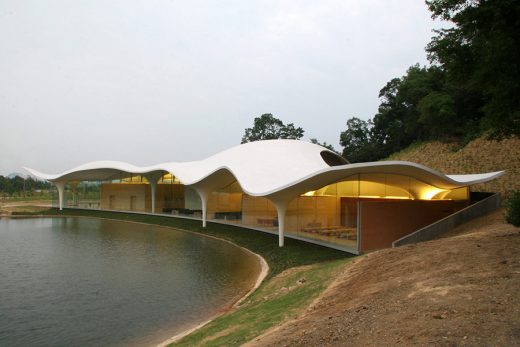
photo from architect
Meiso no Mori Municipal Funeral Hall, Kakamigahara-shi, Gifu, Japan
He has received numerous international awards, including in 2010, the 22nd Praemium Imperiale in Honor of Prince Takamatsu; in 2006, The Royal Institute of British Architects’ Royal Gold Medal; and in 2002, the Golden Lion for Lifetime Achievement for the 8th Venice Biennale International Exhibition. All of his honors are listed in the fact summary of this media kit. He has been a guest professor at the University of Tokyo, Columbia University, the University of California, Los Angeles, Kyoto University, Tama Art University, and in the spring semester of 2012, he hosted an overseas studio for Harvard’s Graduate School of Design, the first in Asia.
His works have been the subject of museum exhibitions in England, Denmark, the United States, France, Italy, Chile, Taiwan, Belgium, Spain and numerous cities in Japan. Publications by and about him have appeared in all of those countries and more. He holds Honorary Fellowships in the American Institute of Architects, Royal Institute of British Architects, the Architecture Institute of Japan, the Tokyo Society of Architects and Building Engineers, and the American Academy of Arts and Sciences.
One of his first projects in 1971 was a home in a suburb of Tokyo. Called “Aluminum House,” the structure consisted of wooden frame completely covered in aluminum. Most of his early works were residences. In 1976, he produced a home for his sister, who had recently lost her husband. The house was called “White U” and generated a great deal of interest in Ito’s works. It was demolished in 1997. Of most of his work in the 1980’s, Ito explains that he was seeking to erase conventional meaning from his works through minimalist tactics, developing lightness in architecture that resembles air and wind.
Sendai Mediatheque design by Toyo Ito architect:
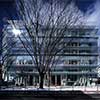
photo : Nacasa & Partners Inc.
Sendai Mediatheque, Sendai-shi, Miyagi, Japan
He calls the Sendai Mediatheque, completed in 2001 in Sendai City, Miyagi, Japan, one of the high points of his career. In the Phaidon book, Toyo Ito, he explains, “The Mediatheque differs from conventional public buildings in many ways. While the building principally functions as a library and art gallery, the administration has actively worked to relax divisions between diverse programs, removing fixed barriers between various media to progressively evoke an image of how cultural facilities should be from now on. This openness is the direct result of its simple structure, consisting of flat concrete slabs (which are honey-comb steel plates with concrete) penetrated by 13 tubes. Walls on each floor are kept to an absolute minimum, allowing the various functions to be freely distributed throughout the open areas between the tubes.”
In delivering the Kenneth Kassler lecture at Princeton University in 2009, Ito explained his general thoughts on architecture:
“The natural world is extremely complicated and variable, and its systems are fluid – it is built on a fluid world. In contrast to this, architecture has always tried to establish a more stable system. To be very simplistic, one could say that the system of the grid was established in the twentieth century. This system became popular throughout the world, as it allowed a huge amount of architecture to be built in a short period of time.
However, it also made the world’s cities homogenous. One might even say that it made the people living and working there homogenous too.
In response to that, over the last ten years, by modifying the grid slightly I have been attempting to find a way of creating relationships that bring buildings closer to their surroundings and environment.” Ito amends that last thought to “their natural environment.”
TOD’S Omotesando Building design by Toyo Ito architect:
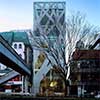
photo : Nacasa & Partners Inc.
TOD’S Omotesando Building, Shibuya-ku, Tokyo, Japan
In the fashionable Omotesando area of Tokyo, Ito designed a building in 2004 for TOD’S, an Italian shoe and handbag company, in which trees are the dominant relationship. The Ito office provides its own description of the project: “Trees are natural objects that stand by themselves, and their shape has an inherent structural rationality. The pattern of overlapping tree silhouettes also generates a rational flow of forces. Having adapted the branched tree diagram, the higher up the building, the thinner and more numerous the branches become, with a higher ration of openings. Similarly, the building unfolds as interior spaces with slightly different atmospheres relating to the various intended uses.
Tower of Winds design by Toyo Ito architect:

photo : Tomio Ohashi
Tower of Winds, Yokohama-shi, Kanagawa, Japan
Rejecting the obvious distinctions between walls and opening, lines and planes, two- and three-dimensions, transparency and opaqueness, this building is characterized by a distinctive type of abstractness. The tree silhouette creates a new image with a constant tension generated between the building’s symbolic concreteness and its abstractness. For this project, we (Ito and his staff) intended to create a building that through its architectural newness expresses both the vivid presence of a fashion brand and strength in the cityscape that will withstand the passage of time.”
Yatsushiro Municipal Museum
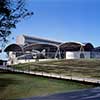
photo : Tomio Ohashi
Municipal Museum, Yatsushiro-shi, Kumamoto, Japan
After designing critically-acclaimed buildings like Sendai Mediatheque, Ito became an architect of international importance during the early-2000s leading to projects throughout Asia, Europe, North America and South America. Ito designed the Main Stadium for the 2009 World Games in Kaohsiung and the under-construction Taichung Metropolitan Opera House, both in Taiwan. In Europe, Ito and his firm renovated the façade of the Suites Avenue Apartments with striking stainless steel waves and, in 2002, designed the celebrated temporary Serpentine Pavilion Gallery in London’s Hyde Park. Other projects during this time include the White O residence in Marbella, Chile and the never-built University of California, Berkeley Art Museum/Pacific Film Archive in California.
Perhaps most important to Ito, however, are the projects in his home country, made more pressing by the earthquake and tsunami of March 11, 2011. The disaster spurred Ito and a group of other Japanese architects to develop the concept of “Home-for-All” communal space for survivors. As Ito says in Toyo Ito – Forces of Nature published by Princeton Architectural Press: “The relief centers offer no privacy and scarcely enough room to stretch out and sleep, while the hastily tacked up temporary housing units are little more than rows of empty shells: grim living conditions either way. Yet even under such conditions, people try to smile and make do…. They gather to share and communicate in extreme circumstances – a moving vision of community at its most basic. Likewise, what we see here are very origins of architecture, the minimal shaping of communal spaces.
An architect is someone who can make such spaces for meager meals show a little more humanity, make them a little more beautiful, a little more comfortable.”
World Games Main Stadium
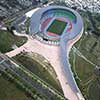
photo : Fu Tsu Construction
Main Stadium, Kaohsiung, Taiwan
For Ito, the fundamental tenets of modern architecture were called into question by “Home-for-All.” He adds, “In the modern period, architecture has been rated highest for its originality. As a result, the most primal themes—why a building is made and for whom—have been forgotten. A disaster zone, where everything is lost offers the opportunity for us to take a fresh look, from the ground up, at what architecture really is. ‘Home-for-All’ may consist of small buildings, but it calls to the fore the vital question of what form architecture should take in the modern era—even calling into question the most primal themes, the very meaning of architecture.”
Taichung Metropolitan Opera House

image : kuramochi+oguma
Metropolitan Opera House, Taichung, Taiwan
The Pritzker Jury commented on Ito’s direct expression of his sense of social responsibility citing his work on “Home-for-All.”
Toyo Ito Museum of Architecture
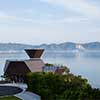
photo : Daici Ano
Toyo Ito Museum of Architecture, Imabari-shi, Ehime, Japan
Recently, Ito has also thought of his legacy, as apparent by the museum of architecture that bears his name on the small island of Omishima in the Seto Inland Sea. Also designed by Ito, the museum opened in 2011 and showcases his past projects as well as serving as a workshop for young architects.
Silver Hut House
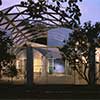
photo : Tomio Ohashi
Silver Hut House, Nakano-ku, Tokyo, Japan
Two buildings comprise the complex, the main building “Steel Hut” and the nearby “Silver Hut,” which is a recreation of the architect’s former home in Tokyo, built in 1984.
Toyo Ito Architecture
Tama Art University Library

photo : Ishiguro Photographic Institute
Art University Library, Hachioji-shi, Tokyo, Japan
Matsumoto Performing Arts Centre
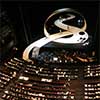
photo : Hiroshi Ueda
Performing Arts Centre, Matsumoto-shi, Nagano, Japan
Za-Koenji Public Theatre
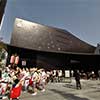
photo from architect
Za-Koenji Public Theatre, Suginami-ku, Tokyo, Japan
Serpentine Gallery

image from architect
Serpentine Gallery, London, UK
Location: Fujiya Bldg., 1-19-4, Shibuya, Shibuya-ku, Tokyo, 150-0002, Japan
Toyo Ito Japan Practice Information
Toyo Ito & Associates, Architects are based in Tokyo
Toyo Ito Architect Background
1941 in Keijo (Seoul), Korea (Japanese)
Education:
The University of Tokyo, Department of Architecture
Graduated 1965
Worked:
Kiyonori Kikutake Architect and Associates
1965-69
Founded:
Urban Robot (URBOT) studio in Tokyo
1971
Became Toyo Ito & Associates, Architects
1979
Architecture Awards
Toyo Ito Awards
1986
Architectural Institute of Japan Prize
for the Silver Hut
1992
33rd Mainichi Arts Award
for the Yatsushiro Municipal Museum
1997
Invited to the proposal competition for The Museum of Modern Art, New York
“Interach ‘97” Grand Prix of the Union of Architects
from the International Academy of Architecture
1998
Ministry of Education Award for the Encouragement of Arts
for the Dome in Odate
1999
Japan Art Academy Prize
for the Dome in Odate
2000
The Arnold W. Brunner Memorial Prize in Architecture
from the American Academy of Arts and Letters
Accorded the title “Academician” from the
International Academy of Architecture
2001
Grand Prize of Good Design Award
Japan Industrial Design Promotion Organization
for Sendai Mediatheque
2002
World Architecture Awards 2002
Best Building in East Asia for Sendai Mediatheque
Golden Lion for Lifetime Achievement
8th International Architecture Exhibition
at the Venice Biennale
2003
Architectural Institute of Japan Prize
for Sendai Mediatheque
Honorary Diploma of the Architectural Association
2004
XX ADI Compasso d’Oro Award
for “Ripples” (wooden bench)
IAA Annual Prize
2006
Royal Gold Medal
Royal Institute of British Architects
Public Building Award for Sendai Mediatheque
2007
Premios Delta ADI FAD
Delta de plata for “Naguisa” (urban furniture)
2008
ADI Compasso d’Oro Award
for “Stand Horm 2005”
6th Austrian Frederick Kiesler Prize
for Architecture and the Arts
2009
Medalla de Oro from Circulo de Bellas Artes de Madrid
2010
22nd Praemium Imperiale
for Architecture
The Asahi Prize
2012
Golden Lion for Best National Participation for the Japan Pavilion
13th International Architecture Exhibition
at the Venice Biennale
(Served as Commissioner)
Japanese Architecture
SANAA Architects – famous Japanese design studio
RIBA Gold Medal Winner in 2006
Buildings / photos for the Toyo Ito Architecture page welcome
Website: www.toyo-ito.co.jp

